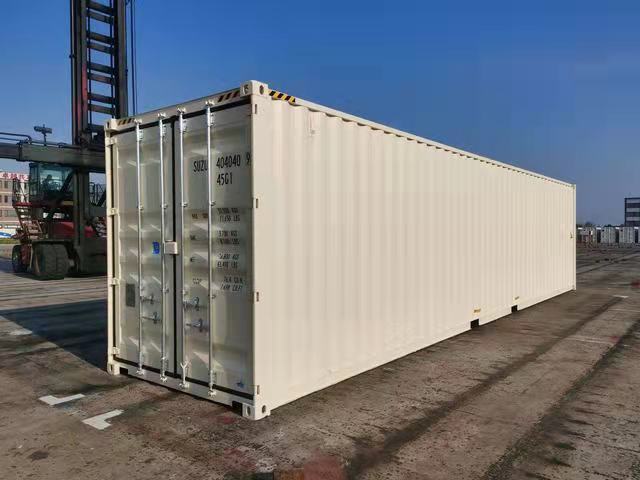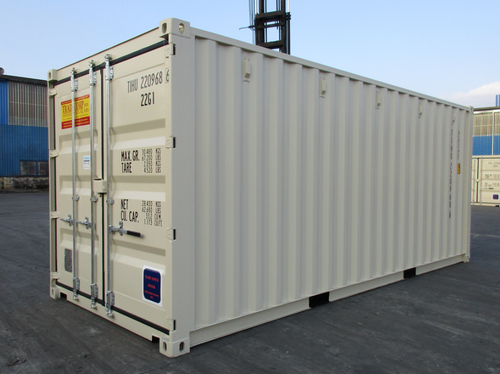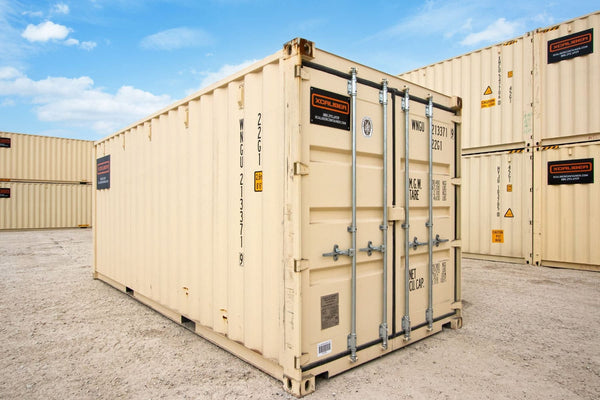How to Maximize Versatility with a New Shipping Container 40 x 8 x 9.6 in Your Next Project
How to Maximize Versatility with a New Shipping Container 40 x 8 x 9.6 in Your Next Project
Blog Article
The Ultimate Guide to Selecting the Right Delivery Container for Your Demands
When it pertains to picking the appropriate shipping container, understanding your specific needs is vital. You'll desire to think about factors like dimension, kind, and product to guarantee you make the finest option. From basic dimensions to specialized choices, there's a whole lot to discover. And also, budgeting for both the container and any kind of modifications can make a huge difference. Let's damage down the essential elements to help you discover the best fit for your demands.
Comprehending Shipping Container Sizes
When you're choosing a delivery container, recognizing the various sizes available is essential for making the appropriate choice. Delivering containers generally come in basic lengths of 20 and 40 feet, yet you'll also locate other measurements. Recognizing the dimension you require depends on what you plan to store or transport.If you're moving smaller sized things, a 20-foot container could be optimal, while larger shipments frequently require a 40-foot container. The elevation can also vary; high cube containers provide extra upright room, which can be useful for taller goods.Before making a decision, determine your freight, and consider exactly how much room you'll need for loading and dumping. Constantly consider possible future needs-- going with a slightly bigger container may save you inconvenience down the line. Ultimately, picking the best dimension will boost efficiency and ensure your things are secure during transit
Types of Delivery Containers Available
There are a number of kinds of delivery containers readily available, each designed for certain objectives and cargo needs. The typical completely dry container is versatile, excellent for general freight. If you're delivering perishable products, consider a cooled container, which keeps a controlled temperature. For large products, high cube containers use extra height, suiting taller loads.If you need to deliver hefty equipment or devices, level rack containers provide a durable base without walls. Open-top containers enable for simple loading of high freight, with a removable tarpaulin covering for defense. If you're looking for flexibility, consider a collapsible container that can be easily saved when not in use.Lastly, specialized containers like storage tank containers are made use of for fluids, while vented containers are designed for bulk freight that requires ventilation. Recognizing your freight kind will certainly aid you choose the appropriate container to meet your delivery requires effectively.
Product Considerations for Durability
When selecting a delivery container, the product plays a vital duty in its durability. You'll want to consider the benefits of steel versus aluminum, specifically regarding corrosion resistance. Understanding these aspects can help you make an extra enlightened selection for your delivery requires.
Steel vs. Aluminum Containers
How do you choose between steel and aluminum containers for your delivery needs? Beginning by taking into consideration longevity. Steel containers are durable and deal outstanding strength, making them perfect for heavy lots and harsh problems. They stand up to damage from effects and are commonly cheaper, which can be a significant factor for budget-conscious buyers.On the various other hand, aluminum containers are lightweight, which can save you on shipping prices. They're much easier to steer and are an excellent option if you need to deliver items often. Light weight aluminum is normally much more pricey and much less durable than steel. Evaluate your specific demands meticulously, consisting of weight, cost, and the sort of cargo you'll be delivery, to make the best choice for your scenario.
Rust Resistance Variables
Selecting the appropriate material does not just include weight and expense; rust resistance plays a substantial role in longevity. When selecting a delivery container, think about the atmosphere it'll encounter. Steel containers, while solid, can corrosion otherwise correctly dealt with. Seek options with protective coverings or galvanization to enhance their life expectancy. Light weight aluminum, on the various other hand, supplies natural corrosion resistance, making it optimal for seaside areas or humid problems. Nonetheless, it can be more costly. Furthermore, analyze the container's usage-- if it'll be subjected to chemicals or harsh weather, prioritize products that can withstand these problems. Spending in a corrosion-resistant container now can save you from expensive fixings or replacements down the line. Select carefully for lasting benefits.
Modifications and Personalization Options
Shipping containers aren't simply for transferring products; more information they can be transformed to meet your specific demands through different alterations and modification options. You can convert a basic container into a comfy workplace room, a short-lived retail store, or even a personal health club. The opportunities are nearly endless.Think about including home windows, insulation, or ventilation to enhance convenience. You might also take into consideration electrical circuitry, plumbing, or perhaps personalized shelving to improve functionality. If protection's an issue, enhanced locks can give tranquility of mind.For visual charm, you can repaint the container or include an one-of-a-kind style to make it stand out. Do not forget flooring choices-- whether you desire sturdy plywood or something a lot more innovative, it can elevate the space.Ultimately, tailoring your delivery container to suit your requirements can enhance functionality and produce an unique atmosphere that mirrors your style.
Analyzing Your Transportation Demands
When it comes to using your changed delivery container, recognizing your transportation needs is vital. Begin by establishing what you'll be delivery-- whether it's heavy equipment, retail items, or individual items. Each kind of freight has different needs relating to size, weight, and accessibility.Next, think about the distance and mode of transportation. Are you shipping locally, country wide, or internationally? This affects the container's design and performance. If you're using trucks, ensure your container fits typical measurements for easy loading and unloading.Additionally, consider transit conditions. Will your products require special defense from weather or temperature level fluctuations? If so, you may require insulation or air flow features in your container.Lastly, analyze just how commonly you'll be moving items. Regular shipments may call for a more durable and versatile container to meet recurring demands. By attending to Visit This Link these variables, you'll be well-prepared to choose the appropriate shipping container for your demands.
Budgeting for Your Shipping Container
Setting a budget plan for your shipping container is essential for making certain a smooth getting process. First, determine how much you can manage to spend. Prices can differ significantly based on dimension, condition, and type. New containers normally set you back extra, but utilized ones can supply significant savings.Next, think about any extra costs you might sustain, such as transport fees, distribution fees, and adjustments. If you prepare to customize the container, consider those costs too. Research study various suppliers to compare prices and locate the finest deal that satisfies your needs.Don' t fail to remember to consist of any kind of licenses or guidelines that might relate to your purchase and use the container. By clearly detailing your budget plan, you'll be much better prepared to make enlightened choices, guaranteeing you obtain the appropriate container without breaking the financial institution.
Maintenance and Care for Long life
To guarantee your shipping container lasts for years, regular upkeep is essential. Beginning by inspecting the exterior for corrosion, dents, and damage. If you spot any kind of issues, resolve them instantly to stop further degeneration. Clean the container occasionally, both in and out, to get rid of dirt, debris, and moisture that can cause corrosion.Ensure the doors seal correctly and oil the joints to stay clear of corrosion and sticking. If you're making use of the container for storage, think about including ventilation to lower humidity and mold growth. For added defense, use a rust-inhibiting paint or sealer annually.If your container's situated in an extreme setting, like seaside areas, you might require to raise upkeep frequency. Keep an eye on the floor covering, also; any kind of signs of wear should be repaired right away. With these straightforward steps, More hints you'll prolong the life of your delivery container significantly.
Regularly Asked Inquiries
Exactly how Do I Find a Dependable Shipping Container Provider?
To discover a dependable delivery container vendor, start by looking into on the internet evaluations, requesting recommendations from good friends or sector contacts, and contrasting prices. Always inspect their credentials and guarantee they offer quality containers that fulfill your requirements.

Can I Rental Fee a Shipping Container As Opposed To Purchasing?
Yes, you can absolutely rent out a shipping container rather of acquiring one. Many distributors supply rental choices, which can conserve you cash and give adaptability if you just need it for a short period.
What Permits Are Required for Container Positioning?

Are Delivery Containers Weatherproof and Suitable for Outdoor Storage?
Yes, delivering containers are normally weatherproof, designed to hold up against severe conditions. Their durable building maintains your products safe and dry, making them suitable for outside storage. Just assure appropriate air flow to avoid dampness build-up inside.
Just how Do I Move a Delivery Container When Purchased?

Report this page